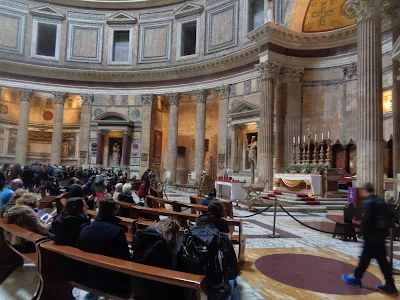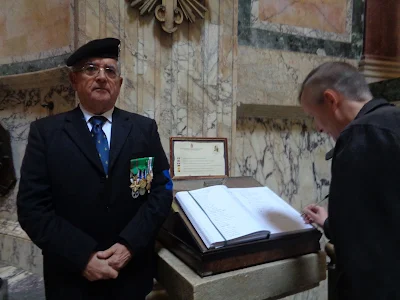Royal destination The Pantheon in Rome Italy
One of the most amazing ancient buildings in Rome, the capital of Italy,
is the Pantheon.
The Pantheon is an amazing building not only due to its history but
also due to its architecture and due to the light effect inside.
Some Royal History
The original Pantheon was completed during the reign of Emperor Hadrian
about 126 after Christ as a Roman Temple for all godness.
In 609, Byzantine Emperor Pochas gave the Pantheon to Pope
Bonifacae IV. He converted it to a Christian church.
During the Renaissance the Pantheon has been the burial site of many
important persons such as the painter Rafael and the architect
Baldassare Peruzzi.
In the 17th. century, Pope Urban VIII ordered to melt down the ceilings
to use it for the Castel Sant' Angelo.
More about the Castel Sant' Angelo on this link.
In modern history two Kings of Italy were buried at the Pantheon:
- Victor Emmanuel II of Italy
- King Umberto I of Italy
one Queen also was buried at the Pantheon:
- Queen Margherita of Italy
Architecture
The Pantheon has monolithic granite columns with shafts 50 Roman feet tall,
weighting about 100 tons and capitals 10 Roman feet tall in the Corinthian
style.
The grey granite columns that were used at the Pantheon were
quarried in Egypt at Mons Claudianus in the eastern mountains. Each was
39 feet (11.9 metres) tall, 5 feet (1.5 metres) in diameter and 60 tons in weight.
They were floated by barge down the Nile River, when the water level was high
during the spring floods and then they were transferred to ships to cross the
Mediterranian Sea.
The doors of the Pantheon were not the original ones, they were placed around
the 15th. century.
Interior
The entrance of the Pantheon is the rectangular area located at the front of the
temple.
Inside the Pantheon the dome really is extraordinary. The contrast of the light
from the dome and the darkness of the Temple brings a great effect.
Lookalikes
As the Pantheon is one of the best-preserved example of an Ancient Roman
Monumental building, it has been enormously influential in the Western
Architecture.
Notable lookalikes are:
- Santa Maria Assunta in Ariccia
- Belle Isle House in England
- Thomas Jefferson's library at the University of Virginia
- Rotunda of Mosta in Malta
A visit
I visited the Pantheon in Rome together with my husband in
december 2017.
Then there was a petition to bring the remains of King Victor
Emmanuel III of Italy to the Pantheon in Rome. See my previous
blogpost about the King and World War II on this link. However his
remains weren't brought back to the Pantheon in Rome but to the
family vault near Turin.
Besides this, the Pantheon really is worth a visit, due to its age,
history, royal burial site and the great architecture (outside and
inside).
is the Pantheon.
The Pantheon is an amazing building not only due to its history but
also due to its architecture and due to the light effect inside.
 |
| Pantheon in Rome Italy - own picture taken in 2017 |
Some Royal History
The original Pantheon was completed during the reign of Emperor Hadrian
about 126 after Christ as a Roman Temple for all godness.
In 609, Byzantine Emperor Pochas gave the Pantheon to Pope
Bonifacae IV. He converted it to a Christian church.
During the Renaissance the Pantheon has been the burial site of many
important persons such as the painter Rafael and the architect
Baldassare Peruzzi.
In the 17th. century, Pope Urban VIII ordered to melt down the ceilings
to use it for the Castel Sant' Angelo.
More about the Castel Sant' Angelo on this link.
In modern history two Kings of Italy were buried at the Pantheon:
- Victor Emmanuel II of Italy
- King Umberto I of Italy
one Queen also was buried at the Pantheon:
- Queen Margherita of Italy
 |
| The tomb of King Victor Emmanuel II at the Pantheon in Rome |
Architecture
The Pantheon has monolithic granite columns with shafts 50 Roman feet tall,
weighting about 100 tons and capitals 10 Roman feet tall in the Corinthian
style.
The grey granite columns that were used at the Pantheon were
quarried in Egypt at Mons Claudianus in the eastern mountains. Each was
39 feet (11.9 metres) tall, 5 feet (1.5 metres) in diameter and 60 tons in weight.
They were floated by barge down the Nile River, when the water level was high
during the spring floods and then they were transferred to ships to cross the
Mediterranian Sea.
The doors of the Pantheon were not the original ones, they were placed around
the 15th. century.
 |
| Inside the Pantheon in Rome |
Interior
The entrance of the Pantheon is the rectangular area located at the front of the
temple.
Inside the Pantheon the dome really is extraordinary. The contrast of the light
from the dome and the darkness of the Temple brings a great effect.
 |
| Dome of the Pantheon in Rome Italy |
Lookalikes
As the Pantheon is one of the best-preserved example of an Ancient Roman
Monumental building, it has been enormously influential in the Western
Architecture.
Notable lookalikes are:
- Santa Maria Assunta in Ariccia
- Belle Isle House in England
- Thomas Jefferson's library at the University of Virginia
- Rotunda of Mosta in Malta
A visit
I visited the Pantheon in Rome together with my husband in
december 2017.
Then there was a petition to bring the remains of King Victor
Emmanuel III of Italy to the Pantheon in Rome. See my previous
blogpost about the King and World War II on this link. However his
remains weren't brought back to the Pantheon in Rome but to the
family vault near Turin.
 |
| Petition at the Pantheon in Rome (my husband was signing it :-) ) |
Besides this, the Pantheon really is worth a visit, due to its age,
history, royal burial site and the great architecture (outside and
inside).



Comments